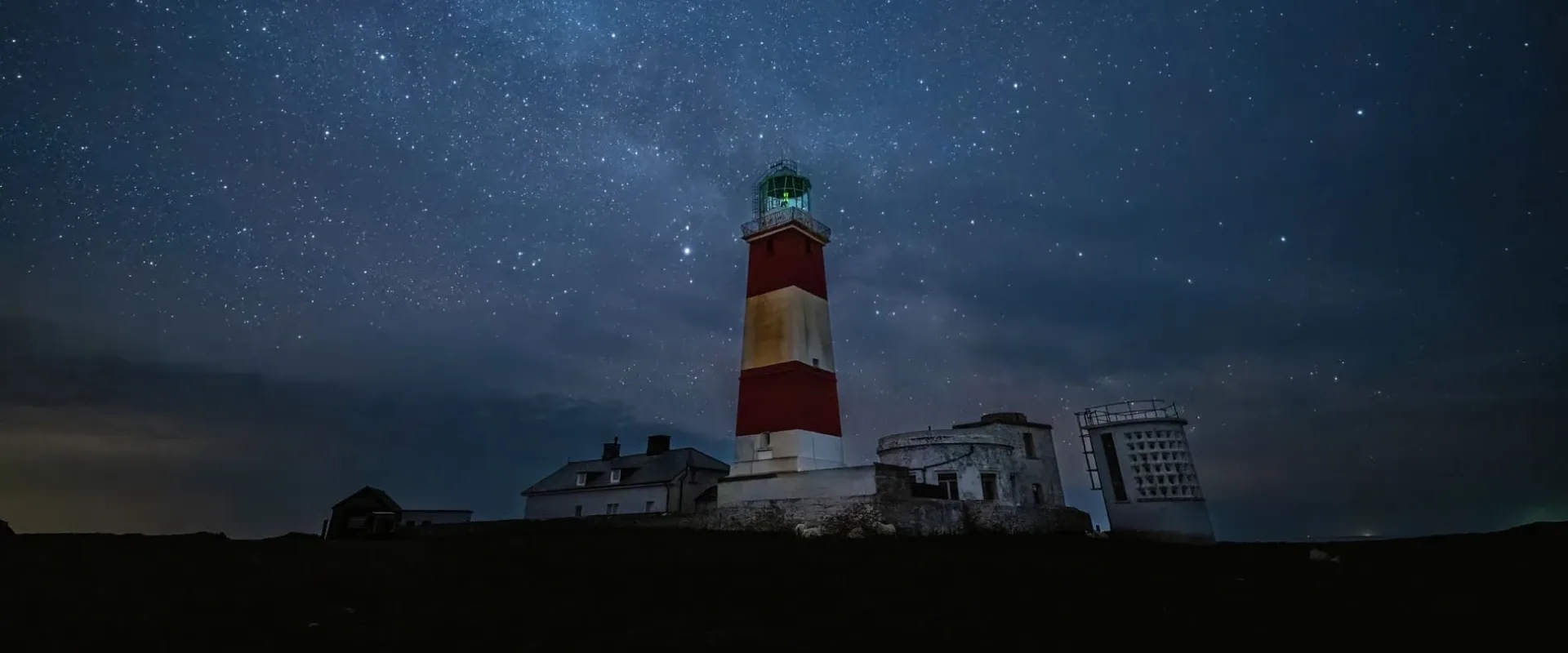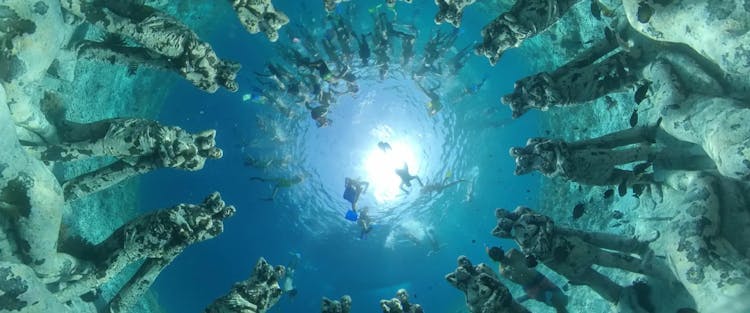
Go Stargazing on Ynys Enlli, Europe’s First Dark Sky Sanctuary
Wales has the proud accolade of the world's highest percentage of land protected by Dark Sky status, at 18%. Here, you'll find a network of protected International Dark Sky Reserves and Dark Sky Parks alongside smaller Dark Sky Discovery Sites, where you can seek starry skies over dramatic Welsh landscapes.
I've chased the clear celestial skies all over Wales, including Usk Reservoir—a Dark Sky Discovery Site in Bannau Brycheiniog (Brecon Beacons) National Park. I love to wrap up warm and enjoy the stillness and kaleidoscope of color as golden hues fade to sapphire blues and, finally, into inky black skies punctuated by pinpricks of light. As the darkness intensifies and the temperature drops, the dark skies above become a luminous tapestry of stars, planets, and the ethereal glow of our home galaxy—the Milky Way—all visible to the naked eye. (If you're lucky, you can also catch the International Space Station, thousands of satellites orbiting the Earth, or a thrilling meteor shower.)
Along with the satisfaction of starry snaps for social, there's also a meditative quality to stargazing, a quiet contemplation on an incomprehensible expanse of space and time. Every time I look upward at the night sky, I feel a sense of smallness in the grandeur of the cosmos, yet simultaneously, an unshakeable connection to the universe and its infinite possibilities.

This childlike sense of wonder keeps me returning to the remote corners of my homeland and seeking out new star-filled spots. The island of Ynys Enlli in Wales—Europe's first Dark Sky Sanctuary—is one such place.
Known primarily for its birdlife and ancient Celtic monastery, rugged Ynys Enlli (Bardsey Island in English) suddenly garnered global interest when it received International Dark Sky Sanctuary certification from the International Dark Skies Association (IDA) in February 2023, joining 17 other sites worldwide—and becoming Europe’s first—with such a designation.
Found two miles off the Llŷn Peninsula in northwest Wales, Enlli's location and geographical features make it one of the darkest places in the UK. The nearly 548-foot-tall mountain serves as an effective barrier on the 1.5-mile-long and 0.5-mile-wide island, limiting light from the mainland and resulting in obsidian-black night skies.
International Dark Sky Sanctuaries (IDSS) are typically situated in remote locations with low light pollution and an exceptional quality of starry nights. With its new designation, the small Welsh island follows specific dark sky policies implemented to protect and maintain the darkness of the core zone. These include careful light management plans, protection of nocturnal habitats, ensuring public enjoyment of the clear night sky, and promoting its unique astro-offerings.

Achieving IDSS status for Enlli was no small feat. Local wardens carried out a four-year program as part of the Dark Sky reserve application to monitor the quality of the night sky to demonstrate that the island was sufficiently dark to qualify for the designation. The IDA also required a lighting management plan and photographic evidence for this certification.
As visitor demand grows, the Bardsey Island Trust aims to continue protecting the dark skies above Ynys Enlli by raising awareness of this unique location in Wales and promoting the importance of the dark skies locally and nationally.
Ynys Enlli’s designation is just the tip of the iceberg when it comes to Wales’ position as a leader in night-sky protection. Welsh councils are keen to capitalize on the burgeoning astro-tourism industry, investing money and resources into potential dark sky sites. In 2020, Powys council pledged £10 million over the next decade to mid-Wales towns looking to change their street lighting to reduce carbon emissions and enhance star viewing.
Like me, Welsh night photographer Dafydd Wyn Morgan had always wanted to visit Ynys Enlli. So, when he heard the island's dark sky status announcement, the night photography workshop leader quickly organized an overnight trip to the Hendy House, the northernmost property on the island.
"Staying on the island was amazing," says Dafydd. “The welcome was so Welsh and genuine. I was met by just one person and one of the very few inhabitants of the island.”
Luckily for Dafydd, his first two nights were clear, perfect for shooting images of island life after dark. Dafydd discovered just how worthy the island was of its newly bestowed status on the second night when his Aurora Alerts App alarm went off, and it was all stations go.
"I had to move quite quickly, as I knew the aurora borealis might not last long," says Dafydd. He snapped more than 50 aurora photographs, using two cameras at different locations to get timelapse footage of the ethereal, shimmering colors.

The increased aurora displays in the UK have driven increased interest in dark sky sites, with visitors hoping to glimpse the elusive northern lights.
The rustic and simply furnished accommodations, which include electric-free lofts and single cottages outfitted with LED lamps, are scattered across the island's north side. They’re only available from April to October, and demand is sky-high. In 2024, star seekers and aurora chasers should move fast to secure a spot—myself included.
Despite previously visiting the island during waking hours, I have not yet been able to experience Enlli at night, due to the wild Welsh weather, far-from-perfect public transport options, and limited accommodation availability. Wales has a notoriously unpredictable climate year-round, so patience and flexibility are vital for planning starry adventures here.
For now, I'm patiently waiting and planning for my chance to marvel at the island’s star-filled expanse, pondering the nature of the universe, its origins, and its evolution. I’m also making a mental note to pack a rain jacket.
Getting there
- The closest major airports to Ynys Enlli are Birmingham (BHX) or Manchester (MAN). From either airport, you’ll take a train to Pwllheli, and then a taxi or local bus to Aberdaron, the small village where boats to the island depart. Boats to Ynys Enlli are operated by Colin Evans, who offers regular crossings from Porth Meudwy near Aberdaron. The boat journey usually takes 15–30 minutes, depending on the weather. Boats to the island only run from April to October, and the schedule is highly dependent on the wild Welsh weather.
- Average Going price for cheap flights to the United Kingdom: $500 roundtrip
How to do it
- Best time to go: You must stay overnight to stargaze on the island. Enlli's charming accommodations are available from April to October, and you'll need to book fast. The best time for stargazing is during the New Moon phase, when the sky is the darkest. This usually happens once a month, so keep an eye on the lunar calendar or download a moon-tracking app.
- Cost: Cost varies depending on your chosen accommodation and length of stay. Bookings are organized through the Bardsey Island Trust and typically run from Saturday to Saturday. They also take short-break bookings for 3–4 nights upon request and availability.
- Considerations: It’s vital that you minimize light pollution while on the island. Avoid using bright lights and turn off any unnecessary lights in your accommodation. Use the Clear Outside app to monitor the weather conditions and cloud coverage at a location; the NightCap Camera app helps you take night-sky photos on your phone. Remember to bring all your essentials for stargazing, including a red flashlight (to prevent excess light), warm clothing, and a thermos for hot drinks.
- Photo tips: With the correct settings, you can capture detailed shots of the stars or northern lights during your stay. Here are some camera settings to try:
- Set your aperture to f/2.8
- Start with an ISO of 3200-6400
- Use a shutter speed of 10–25 seconds
- Use a focal length of 14mm if you have a full-frame camera
Other cool experiences in Europe
Published February 20, 2024
Last updated February 22, 2024
Articles you might like
View AllTreat your travel to cheap flights
Most deals are 40-90% off normal prices with great itineraries from the best airlines. If it's not an amazing deal, we won't send it. Sign up for free to start getting flight alerts.




